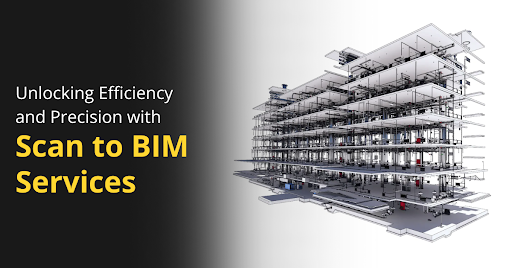
In the realm of architectural and construction projects, precision, efficiency, and accuracy are paramount. The advent of technology has significantly revolutionized the industry, offering innovative solutions to age-old challenges. One such groundbreaking innovation is Scan to BIM services, a transformative process that seamlessly integrates laser scanning technology with Building Information Modeling (BIM) methodologies.
In this comprehensive guide, we delve into the intricacies of Scan to BIM services, exploring its significance, applications, and benefits for the architecture, engineering, and construction (AEC) sector.
Understanding Scan to BIM Services
Scan to BIM services entail the conversion of laser scan data or point cloud data into intelligent 3D BIM models. This process involves capturing the existing conditions of a structure or site through advanced laser scanning techniques and subsequently transforming the raw scan data into accurate BIM models using sophisticated software such as Autodesk Revit.
By bridging the gap between the physical environment and digital representation, Scan to BIM services facilitate seamless collaboration, visualization, and decision-making throughout the project lifecycle.
The Process: From Scan to 3D Model
The journey from scan to model encompasses several key stages, each essential for ensuring the accuracy and fidelity of the final BIM deliverables:
1. Laser Scanning:
The process commences with the deployment of high-precision laser scanning equipment to capture detailed 3D point cloud data of the existing site or structure. These laser scanners employ LiDAR (Light Detection and Ranging) technology to precisely measure distances and gather spatial information, crucial for accurate 3D Scan to BIM conversion. This stage lays the foundation for precise Point Cloud to BIM services.
2. Data Acquisition:
Once the scanning is complete, the collected point cloud data is processed to remove noise, errors, and inconsistencies. Advanced software tools are utilized to register multiple scans, align data sets, and create a cohesive representation of the scanned environment, a fundamental step in Point Cloud to BIM services. This meticulous process ensures the fidelity of the 3D Laser Scan to BIM
3. Model Generation:
With the clean and registered point cloud data at hand, skilled BIM professionals commence the model generation phase. Using specialized software such as Autodesk Revit, they meticulously translate the scanned data into intelligent 3D BIM models.
This involves creating accurate representations of structural elements, architectural features, MEP (Mechanical, Electrical, Plumbing) systems, and other components based on the scan data, a crucial aspect of Scan to BIM modeling. Attention to detail is paramount in ensuring the accuracy of Revit Scan to BIM.
4. Model Validation:
Quality assurance and validation play a crucial role in the Scan to BIM process. The generated BIM models undergo rigorous scrutiny to ensure alignment with project requirements, standards, and specifications.
Any discrepancies or inconsistencies are addressed and rectified to maintain the integrity of the final deliverables, ensuring the accuracy of Revit Scan to BIM.
5. Integration and Collaboration:
Once validated, the Scan to BIM models seamlessly integrate with the overarching BIM workflow, facilitating collaboration among project stakeholders. These models serve as a central repository of information, enabling architects, engineers, contractors, and other stakeholders to visualize, analyze, and coordinate various aspects of the project more effectively, promoting collaboration among Scan to BIM companies.
Applications of Scan to BIM Services
Scan to BIM services find widespread applications across diverse sectors within the AEC industry, offering tangible benefits in terms of efficiency, accuracy, and cost-effectiveness. Some common applications include:
1. As-Built Documentation:
Scan to BIM services enable the accurate documentation of existing structures, providing as-built models that serve as a reference for renovation, retrofitting, or restoration projects, essential for historic preservation. These models serve as a valuable resource for facility management.
2. Facility Management:
The generated BIM models serve as valuable assets for facility management, allowing stakeholders to efficiently manage, maintain, and operate built assets throughout their lifecycle, streamlining facility management processes. They serve as a foundation for facility management software integration.
3. Clash Detection and Coordination:
By integrating Scan to BIM models with clash detection software, project teams can identify and resolve clashes or conflicts between different building systems, minimizing errors and rework during construction, and optimizing construction planning and sequencing. This fosters efficient construction planning.
4. Historic Preservation:
In the realm of historic preservation and conservation, Scan to BIM services facilitate the digital preservation of heritage structures, ensuring their documentation and restoration with unparalleled accuracy and fidelity, vital for historic preservation efforts. These models aid in historic preservation planning and restoration.
5. Construction Planning and Sequencing:
Scan to BIM models aid in construction planning and sequencing by providing detailed insights into site conditions, spatial constraints, and logistical considerations, thereby optimizing construction workflows and resource allocation, aiding in construction planning. They streamline construction sequencing and resource management.
Also read, MEP Revit Modeler vs HVAC Design Engineer – Difference
Benefits of Scan to BIM Services
The adoption of Scan to BIM services offers a myriad of benefits that significantly enhance project outcomes and stakeholder satisfaction:
1. Enhanced Accuracy:
By leveraging advanced laser scanning technology, these services deliver highly accurate representations of existing conditions, minimizing errors and discrepancies throughout the project lifecycle, and ensuring the precision of 3D Laser Scan to BIM. This leads to reliable Revit Scan to BIM outcomes.
2. Improved Visualization:
The 3D BIM models generated through Scan to BIM services offer unparalleled visualization capabilities. The allowing stakeholders to explore and understand the project in greater detail, enhancing 3D Scan to Revit visualization. This aids in better project comprehension and decision-making.
3. Streamlined Collaboration:
Scan to BIM models serve as a common platform for collaboration, enabling seamless communication and coordination among project teams. thereby fostering greater efficiency and synergy, essential for Scan to BIM Revit. This facilitates improved Scan to BIM collaboration.
4. Cost and Time Savings:
The precision and efficiency afforded by Scan to BIM services translate into significant cost and time savings, as errors, rework, and delays are minimized, leading to optimized project schedules and budgets, contributing to cost savings. This results in efficient project delivery and reduced project costs.
5. Future-Proofing:
Scan to BIM models serve as valuable assets beyond the construction phase, facilitating ongoing facility management, maintenance, and renovation activities. Thus future-proofing built assets for years to come, ensuring future-proofing of the built environment. This ensures the longevity and sustainability of constructed assets.
Conclusion
Scan to BIM services represent a paradigm shift in the AEC industry. It is offering a transformative approach to capturing, documenting, and modeling existing structures and sites. By harnessing the power of laser scanning technology and BIM methodologies, these services empower project teams to achieve unprecedented levels of accuracy, efficiency, and collaboration.
As the industry continues to embrace digitalization and innovation. These BIM services are poised to play a pivotal role in shaping the future of architectural and construction practices, driving greater sustainability, resilience, and value across the built environment.
Incorporating Scan to BIM Services into Your Workflow Today!
Also read:



